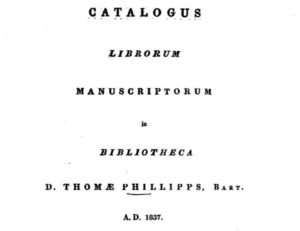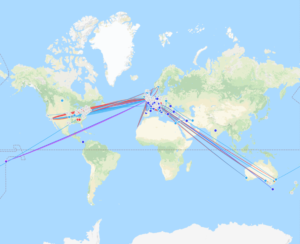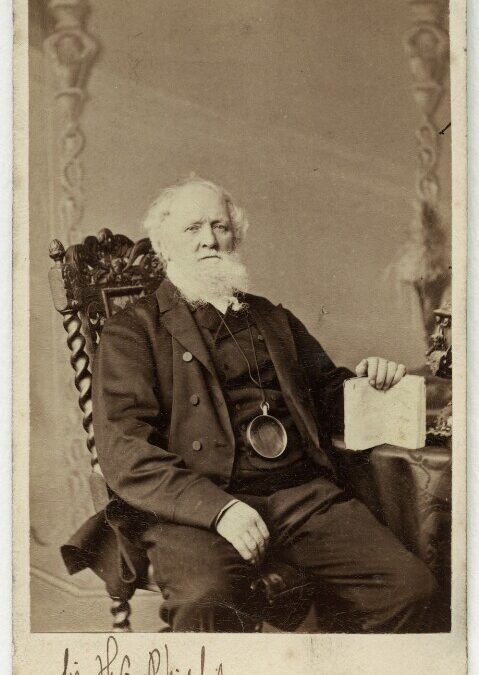Continuing our exploration of Sir Thomas Phillipps’ remarkable manuscript collection, Toby Burrows (University of Oxford; University of Western Australia) examines the fate of the collection – @TobyBurrows

Phillipps’ stamp and number, San Marino, Henry E. Huntington Library, HM 25780
The vast manuscript collection of Sir Thomas Phillipps (1792-1872) was gradually dispersed in the century after his death – mostly through auctions, but also in private sales. The so-called “residue of the residue” was then sold to H.P. Kraus in 1977 and the dispersal continued.
Finding the current or most recent location of a specific manuscript can be challenging. Most of his manuscripts and documents were numbered, so having the Phillipps number greatly assists the finding process – assuming that catalogue entries and database records actually quote the number! The earlier Sotheby’s auction catalogues don’t include Phillipps numbers, for example.
Phillipps’ own printed catalogue covers manuscript numbers up to 23,837 – though the cataloguing and indexing are unreliable: Catalogus librorum manuscriptorum in bibliotheca D. Thomae Phillipps, Bart., available through Google Books and the Internet Archive.
Many Phillipps manuscripts (8,575 in fact) have entries in the Mapping Manuscript Migrations database – look under the “Owner” facet of the “Manuscripts” perspective, or search for a specific number. The data come from the Schoenberg Database of Manuscripts, Bibale, and Medieval Manuscripts in Oxford Libraries.
These sources only cover medieval and Renaissance manuscripts, and generally exclude fragments, cuttings, and individual documents with fewer than five pages. Many Phillipps manuscripts are from a later period.
My own nodegoat database (with about 10,000 entries) adds a few of the later manuscripts, and tries to trace their histories in some detail, as this map shows:

The Bodleian Library, the British Library, Cambridge University Library, and the Institut de recherche et d’histoire des textes have finding aids or card indexes arranged by Phillipps number, but these are neither digitized nor up-to-date.
A. N. L. Munby’s detailed account of the formation and dispersal of the Phillipps collection includes a numerical index to Phillipps manuscripts mentioned in the text: The Dispersal of the Phillipps Library (Phillipps Studies no. 5) (Cambridge, 1960), pp. 121-133.
There are printed lists of Phillipps manuscripts in specific subject areas, such as John Baker’s English legal manuscripts formerly in the collection of Sir Thomas Phillipps (2008) and David Hook’s The Hispanic, Portuguese, and Latin American manuscripts of Sir Thomas Phillipps (2017).
If all else fails, try entering “Phillipps” and the manuscript number in your favourite search engine. This can be surprisingly successful!
It’s important to realize that a significant proportion of Phillipps manuscripts are still in private hands, and these will usually be untraceable.
Follow @cultivate_mss for more on Phillipps and his manuscripts.


Hi, coming to this debate a bit late but the National Library of Ireland should be included as a source . They sent their curators to search for ‘Irish’ mss in the Phillipps collection and were successful in acquiring some. They should have something in their archives to add to this study. There are also some minor Phillips documents in Irish private collections but from what I have seen they are mostly 18thC.
Thanks for this very useful piece of work, it proved an invaluable guide when we were trying to locate an ex-Phillipps MS. Sadly, we couldn’t find it, but at least we knew where to look!
Cardiff Central Library bought much of Sir Thomas Phillipps’s extensive and important Welsh mss. collection in 1895/96. Much – but far from all – of the considerable CCL mss. (both Phillipps items and the much more numerous other material) were microfilmed by the National Library of Wales in the 1980s. The NLW online catalogue has individual entries for the microfilmed mss including their CCL numbers and their Phillipps numbers: https://archives.library.wales/index.php/cardiff-mss-on-microfilm These online entries derive from the index and catalogue of the contents of the 2808 CCL MSS. microfilms by G.C.G.Thomas & D,.Huws which was published as “Summary Catalogue of the manuscripts of South Glamorgan Libraries, Cardiff Central Library, commonly referred to as the ‘Cardiff MSS’ “, Aberystwyth : National Library of Wales, 1994. The CCL MSS. and microfilms include a number of items printed by Phillipps’s Middle Hill Press. From a Welsh perspective, a particular CCL MSS treasure is the “Book of Aneirin” (Llyfr Aneirin), a late 13th century ms. containing Old and Middle Welsh poetry attributed to the late 6th century poet Aneurin: CCL MSS. 2.81, Phillipps mss. no. 16614 (previously Hengwrt Library no.46); due to its importance, this ms. had been filmed prior to the 1980s project to film CCL MSS, and so does not appear in the 2808 CCL MSS microfilms. The Sir John Williams collection of manuscripts in NLW includes 108 Phillipps mss. At least 30 other Phillipps mss. were subsequently were acquired by NLW.
At KU Leuven Libraries, we also have a manuscript of the Phillipps collection (MS 11109), in our library ms. 1383. It is described by John Baker (p. 63).